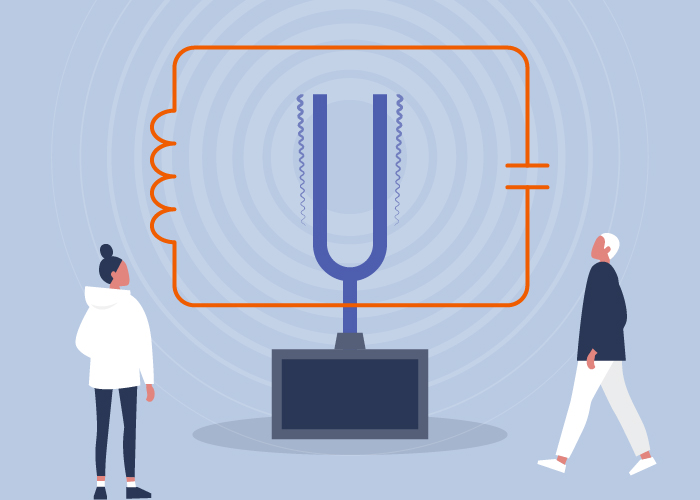
Intro to EMC Topics
Components—Part 2: Chip Beads Reflect and Absorb Noise
Short-range wireless communication technologies such as Wi-Fi and Bluetooth have made it possible for familiar electronic devices to easily send and receive data wirelessly. However, if noise emitted by electronic devices interferes with their built-in antennas, communication may be interrupted and data processing may be reduced. With the emergence of technologies like 5G and the shift towards an IoT society, noise countermeasures are becoming increasingly essential.
Chip beads, which take advantage of the unique characteristics of ferrite, are components that can easily remove noise by being inserted in series with transmission lines that are likely to radiate noise. They are widely used in a variety of devices due to their convenience. It’s also an effective noise countermeasure after a PCB pattern design is completed. Despite its small size, it is a very dependable noise suppression component.
The square wave of a digital signal is a collection of a variety of frequency components
Even the most complex signal waveform that repeats periodically is composed of a sine wave at a fundamental frequency and its integer multiple harmonics. This was shown mathematically through the Fourier series expansion, derived by the 19th-century French mathematician Joseph Fourier. The FFT (Fast Fourier Transform) analyzer (spectrum analyzer), used to analyze signal waveforms and others, is a practical application of this principle. If you analyze the frequency spectrum of various musical instruments, sounds, and human voices using an FFT analyzer, you will find that they consist of a fundamental wave and its harmonics.
The square wave of a digital signal is also the sum of a sine wave at a fundamental frequency and its odd-numbered harmonics. In electronic devices where the high and the low of a waveform represent a digital signal of 0 or 1, noise superimposed on the signal line disturbs the square wave and, if left unchecked, can cause a variety of adverse effects.
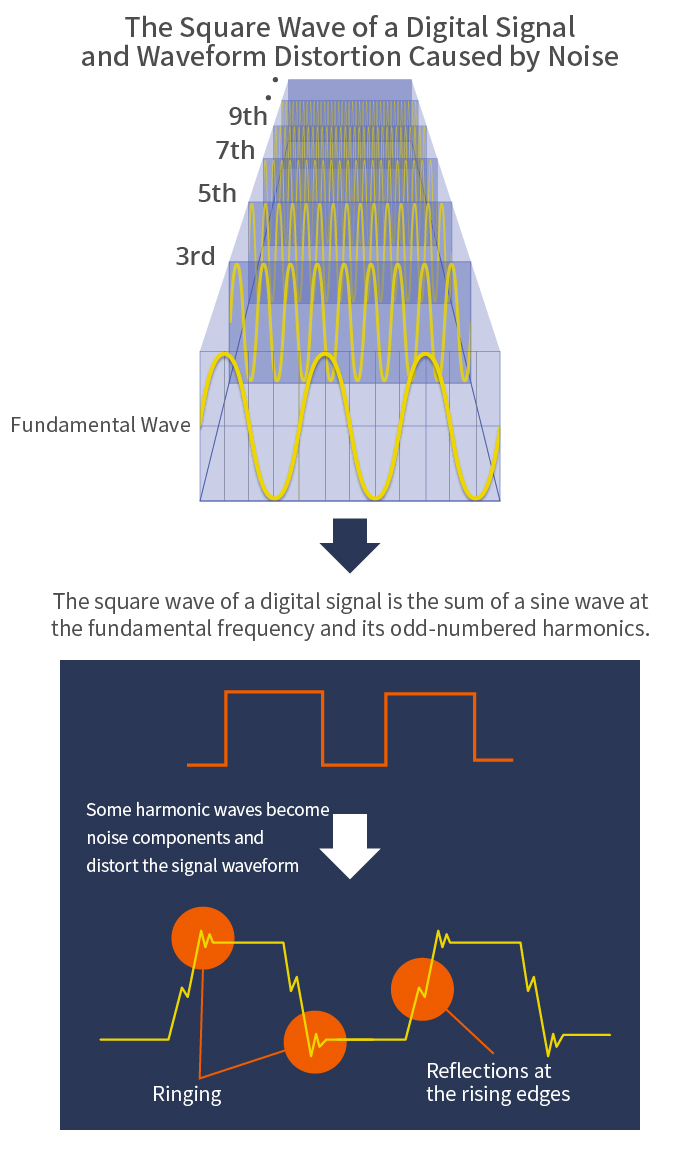
When a current flows through a signal line, magnetic field lines are generated. There is also a resistive component in the signal line, as well as an invisible capacitive component between the signal line and ground called stray capacitance (capacitance created between two conductors with a potential difference). Because of these “hidden elements” in the signal line not drawn anywhere on a circuit diagram, the waveform could get distorted or wriggle around (ringing) even if the input signal is a pristine square wave. In particular, if the impedance (resistance in an AC circuit) of the transmitting and receiving sides is mismatched, the signal will be returned as a reflected wave at the boundary of the signal line, causing the circuit to fail or radiate noise to its surroundings.
In smartphones and other devices where components are mounted in high-densities, noises emitted by the device itself can interfere with a proximate built-in antenna, resulting in poor reception and other issues. This is the so-called autointoxication problem.
Chip beads, which cleverly take advantage of the characteristics of ferrite, are often used as a simple and effective countermeasure for these noise problems. Chip beads are named after perforated beads used in ornaments like necklaces. This stems from the early days when conductors were actually placed through hollow ferrite material. Later, in response to the demand for miniaturization of electronic components, chip beads—with a structure in which a coil is formed inside the ferrite body using laminar fabrication techniques—came to be used. Though no longer a hollow structure, the original “bead” name was retained.
Chip beads blend the properties of both an inductor and a resistor
Noise, just like a signal , is a form of electrical energy. Why, then, are ferrite chip beads able to selectively remove noise components only?
In general, noise is higher in frequency than signals. Chip beads, which have high impedance in the high frequency ranges, act on noise selectively because they do not affect low frequency signals, which are passed through. However, what differentiates a chip bead from an LPF (low-pass filter) is that it has both inductive (coil) and resistive properties. In ranges where the frequency of the noise is relatively low, a chip bead works mainly as an inductor, reflecting and blocking the noise. As the inductive component increases, so will the impedance. However, beyond a certain frequency, the impedance drops sharply and the noise reflection characteristics also diminish rapidly. The frequency at which this occurs is called the self-resonant frequency.
This is where the chip bead’s resistive component takes over the inductive component. High frequency noises are absorbed by the resistive component, converted into heat and removed. This explains why chip beads are effective at removing noise across a wide frequency range. The frequency at which this functional switch occurs is where the resistive component (R = resistance) and the inductive component (X = reactance) become equal, and is called the R-X crosspoint.
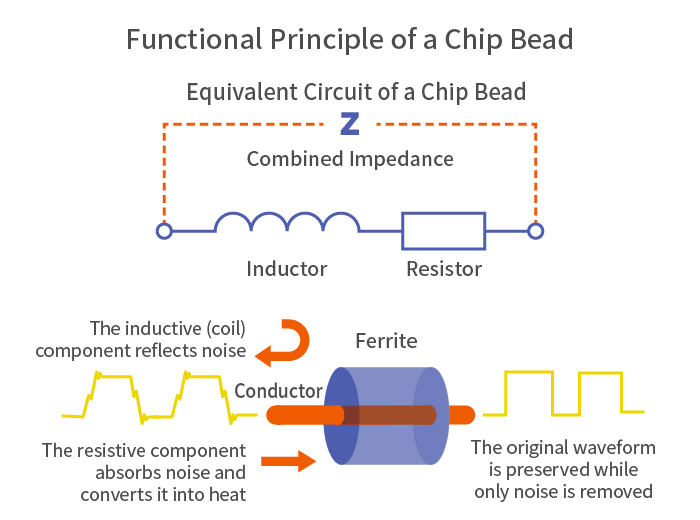
The R-X crosspoint is key when selecting chip beads
Just as you need to use different cold medications for different symptoms, chip beads have a variety of frequency-impedance characteristics, and need to be selected appropriately. When using chip beads, the R-X crosspoint becomes a key factor. Chip beads with an R-X crosspoint on the high frequency side exhibit characteristics similar to inductors, while those with an R-X crosspoint on the low frequency side mainly behave like resistors.
Though it depends on the frequency of the signal, chip beads with an R-X on the low side generally have less ringing, and can correct waveform distortions effectively. However, the choice needs to be made carefully so that necessary signals are not attenuated. It is also desirable to have low DC resistance, as high DC resistance will consume more power and reduce the signal level.
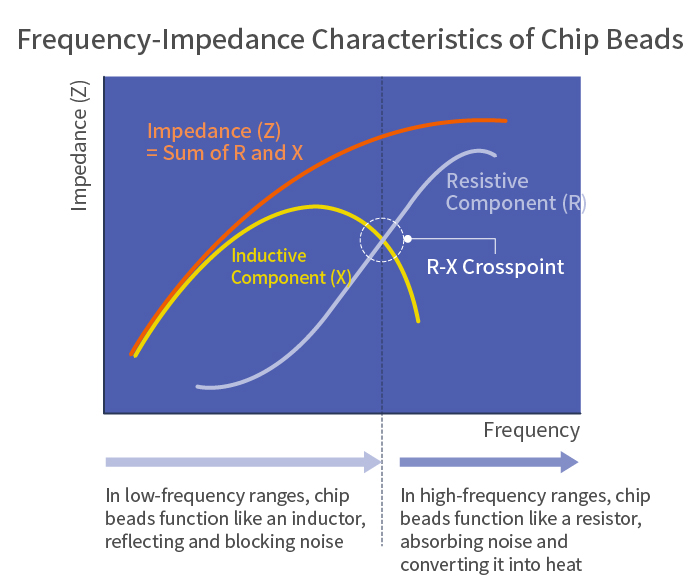
Chip beads with gigaspira structure can counter noise in the GHz bands
Thanks to laminar fabrication techniques, ferrite beads have become available in chip form and have achieved miniaturization. As the frequencies in electronic devices kept rising, however, a new problem emerged: the stray capacitance between the terminal electrodes and the spiral-shaped inner electrodes was hindering the improvement of performance characteristics. A ferrite bead is a simple and effective noise suppressor because of its high impedance over a wide frequency range, but stray capacitance between electrodes reduces impedance in the higher frequencies.
To solve this problem, chip beads featuring a gigaspira structure—also employed in multilayer chip inductors—were introduced. In the past, a chip bead’s inner conductor spirals were stacked perpendicular to the orientation of the terminal electrodes, but with this new fabrication technique, the spirals are stacked in the same direction as the electrodes. This resulted in a dramatic reduction of the stray capacitance between the terminal electrodes and the inner conductors, enabling excellent noise suppression characteristics over a wide frequency range—covering up to the GHz bands with room to spare.
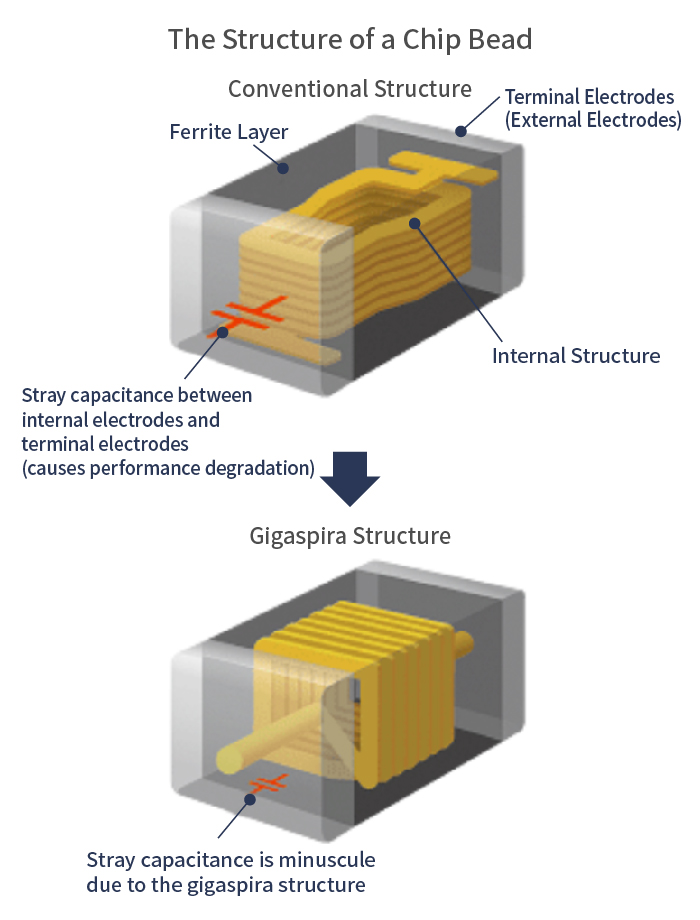
TDK’s robust lineup of chip beads includes ultra-compact products for signal lines, products with a gigaspira structure that provide high impedance in the GHz bands, products that can handle large currents found in power supply lines, as well as products specialized for automotive applications. These products utilize TDK’s proprietary ferrite technology and provide extremely effective noise suppression over a wide frequency range.
TDK is a comprehensive electronic components manufacturer leading the world in magnetic technology



